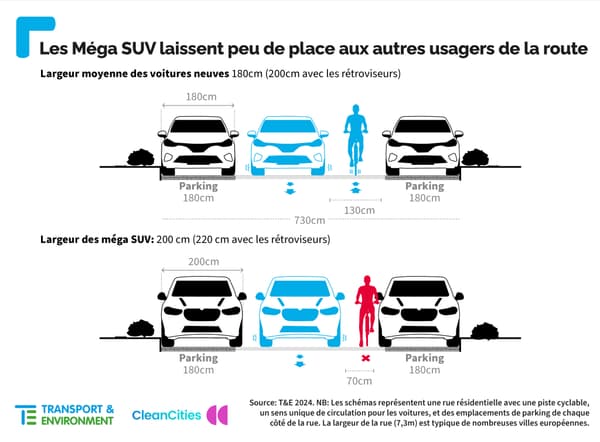Increasingly larger cars are a reality. While Parisians will soon decide the price of parking SUVs, the NGO Transport and Environment publishes a study on the evolution of the average width of new cars sold in Europe.
1 centimeter every 2 years
This increase in volume translates into 1 centimeter of additional width every 2 years. The study thus compares the average width of the 100 best-selling vehicles in the European Union in 2018, with 177.8 centimeters, and in the first half of 2023, with 180.3 centimeters.
In the long term and in car sales as a whole, this rule is also verified according to the NGO: from 170.5 centimeters on average in 2001 to 180.2 centimeters in 2020.
“Among the 100 best-selling models in 2023, 52% exceed 180 cm in width,” highlights a statement from Transport and Environment.
Parking spaces that have become too narrow
For the NGO, cars are no longer suitable for big cities:
“This threshold of 180 centimeters corresponds to the standard minimum width for parking on public roads in large cities, including Paris. As a result, cars protrude and take up too much space,” the press release states.
Among other symptoms of this automobile obesity: in larger spaces, up to 240 centimeters from public roads, for example in underground parking lots, large SUVs are already crowded, “leaving too little space for their occupants and those parked nearby to enter and Get out of the car without having to contort yourself.
Share the path in question
Finally, these increasingly wider SUVs also take up more space on the road, “reducing the space available for other vehicles and cyclists.”
An extension that also translates into a more imposing height, particularly at the front of the vehicle, which does not fail to have consequences on the risk in the event of a frontal impact with pedestrians.
“Selon une étude de l’institut belge VIAS, une augmentation de 10 cm de la hauteur de l’avant des véhicules entails une risque de décès acru de 30 % pour les piétons et les cyclistes victims de un collision”, rappelle Transport & Environment.

What solutions?
The NGO analyzes several solutions to this scourge of large vehicles. First of all, “parking rates depend on the size and weight of the vehicle, so large SUVs and luxury pick-ups pay more,” citing the example of Lyon or the German city of Tübingen and probably soon Paris.
Another idea mentioned: “tax incentives to guide consumers towards lighter and more economical vehicles, and push manufacturers to respond to this demand.” Transport and Environment cites the example of France, with the application of a weight penalty and a bonus amount that in the future could also decrease depending on the mass of the vehicle.
The study also suggests reviewing “the maximum width of new cars when legislation is updated in the coming months.” In fact, the NGO is surprised that “new cars sold in the EU are subject to the same maximum width – 255 cm – as buses and trucks”, with the risk that one day large vehicles “will reach the limit provided for trucks”.
Source: BFM TV


